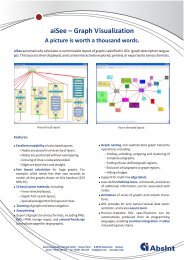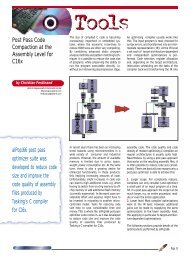Worst-Case Execution Time Prediction by Static Program ... - Absint
Worst-Case Execution Time Prediction by Static Program ... - Absint
Worst-Case Execution Time Prediction by Static Program ... - Absint
You also want an ePaper? Increase the reach of your titles
YUMPU automatically turns print PDFs into web optimized ePapers that Google loves.
3.6 Path Analysis<br />
Path analysis uses the results of pipeline analysis, i.e. the estimated WCETs at the control-flow edges for all<br />
contexts, to compute a WCET estimation for the entire code that is currently analyzed.<br />
Let T (e,c) be the estimated WCET for edge e and context c as determined <strong>by</strong> cache and pipeline analysis. Furthermore,<br />
let C(e,c) be the execution count, which indicates how often control passes along edge e in context c. If<br />
one knows for a specific run of the code the execution counts C(e,c) for each edge e in each context c, then one<br />
can get an upper bound for the time of this run <strong>by</strong> taking the sum of C(e,c) · T (e,c) over all edge-context pairs<br />
(e,c). Thus, the task of obtaining a global WCET estimation can be solved <strong>by</strong> finding a feasible assignment of<br />
execution counts C(e,c) to edge-context pairs that maximizes ∑C(e,c) · T (e,c). The value of this sum is then the<br />
desired global WCET estimate.<br />
Therefore, path analysis is implemented <strong>by</strong> integer linear programming: The path analyzer sets up a system of<br />
linear constraints over the integer variables C(e,c). Then an auxiliary tool looks for a solution of this constraint<br />
system that maximizes ∑C(e,c) · T (e,c). The constraints of the constraint system are derived from the control<br />
structure and from the loop bounds found <strong>by</strong> loop bound analysis or provided <strong>by</strong> the user. Constraints derived<br />
from the control structure are for instance those that assert that the sum of the execution counts of the incoming<br />
edges of a block equals the sum of the execution counts of the outgoing edges. Additional constraints can be<br />
derived from user annotations representing knowledge about dependencies of program parts.<br />
3.7 Analysis of Loops and Recursive Procedures<br />
Loops and recursive procedures are of special interest since programs spend most of their runtime there. Treating<br />
them naively when analyzing programs for their cache and pipeline behavior results in a high loss of precision.<br />
Frequently the first execution of the loop body loads the cache, and subsequent executions find most of their<br />
referenced memory blocks in the cache. Because of speculative prefetching, cache contents may still change<br />
considerably during the second iteration. Therefore, the first few iterations of the loop often encounter cache<br />
contents quite different from those of later iterations. Hence it is useful to distinguish the first few iterations of<br />
loops from the others. This is done in the VIVU approach (virtual inlining, virtual unrolling) [8].<br />
Using upper bounds on the number of loop iterations, the analyses can virtually unroll not only the first few<br />
iterations, but all iterations. The analyses can then distinguish more contexts and the precision of the results is<br />
increased—at the expense of higher analysis times.<br />
4 User Annotations<br />
Apart from the executable, aiT needs user input to find a result at all, or to improve the precision of the result. The<br />
most important user annotations specify the targets of computed calls and branches and the maximum iteration<br />
counts of loops (there are many other possible annotations).<br />
4.1 Targets of Computed Calls and Branches<br />
For a correct reconstruction of the control flow from the binary, targets of computed calls and branches must be<br />
known. aiT can find many of these targets automatically for code compiled from C. This is done <strong>by</strong> identifying<br />
and interpreting switch tables and static arrays of function pointers. Yet dynamic use of function pointers cannot be<br />
tracked <strong>by</strong> aiT, and hand-written assembler code in library functions often contains difficult computed branches.<br />
Targets for computed calls and branches that are not found <strong>by</strong> aiT must be specified <strong>by</strong> the user. This can be done<br />
<strong>by</strong> writing specifications of the following forms in a parameter file called AIS file:<br />
INSTRUCTION <strong>Program</strong>Point CALLS Target1, ..., Targetn ;<br />
INSTRUCTION <strong>Program</strong>Point BRANCHES TO Target1, ..., Targetn ;<br />
<strong>Program</strong> points are not restricted to simple addresses. A program point description particularly suited for CALLS<br />
and BRANCHES specifications is "R" + n COMPUTED which refers to the nth computed call or branch in<br />
routine R—counted statically in the sense of increasing addresses, not dynamically following the control flow. In<br />
a similar way, targets can be specified as absolute addresses, or relative to a routine entry in the form "R" + n<br />
BYTES or relative to the address of the conditional branch instruction, which is denoted <strong>by</strong> PC.





